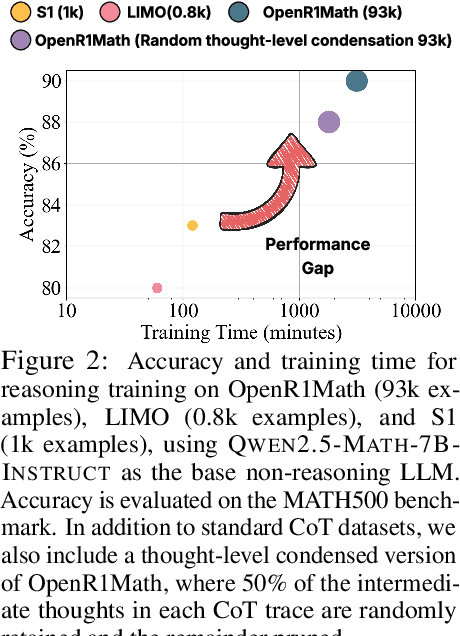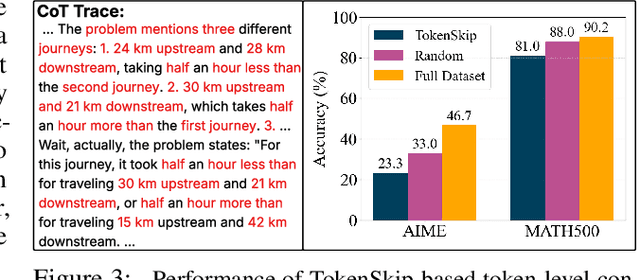Mingyi Hong
BLUR: A Bi-Level Optimization Approach for LLM Unlearning
Jun 09, 2025Abstract:Enabling large language models (LLMs) to unlearn knowledge and capabilities acquired during training has proven vital for ensuring compliance with data regulations and promoting ethical practices in generative AI. Although there are growing interests in developing various unlearning algorithms, it remains unclear how to best formulate the unlearning problem. The most popular formulation uses a weighted sum of forget and retain loss, but it often leads to performance degradation due to the inherent trade-off between forget and retain losses. In this work, we argue that it is important to model the hierarchical structure of the unlearning problem, where the forget problem (which \textit{unlearns} certain knowledge and/or capabilities) takes priority over the retain problem (which preserves model utility). This hierarchical structure naturally leads to a bi-level optimization formulation where the lower-level objective focuses on minimizing the forget loss, while the upper-level objective aims to maintain the model's utility. Based on this new formulation, we propose a novel algorithm, termed Bi-Level UnleaRning (\texttt{BLUR}), which not only possesses strong theoretical guarantees but more importantly, delivers superior performance. In particular, our extensive experiments demonstrate that \texttt{BLUR} consistently outperforms all the state-of-the-art algorithms across various unlearning tasks, models, and metrics. Codes are available at https://github.com/OptimAI-Lab/BLURLLMUnlearning.
EPiC: Towards Lossless Speedup for Reasoning Training through Edge-Preserving CoT Condensation
Jun 04, 2025



Abstract:Large language models (LLMs) have shown remarkable reasoning capabilities when trained with chain-of-thought (CoT) supervision. However, the long and verbose CoT traces, especially those distilled from large reasoning models (LRMs) such as DeepSeek-R1, significantly increase training costs during the distillation process, where a non-reasoning base model is taught to replicate the reasoning behavior of an LRM. In this work, we study the problem of CoT condensation for resource-efficient reasoning training, aimed at pruning intermediate reasoning steps (i.e., thoughts) in CoT traces, enabling supervised model training on length-reduced CoT data while preserving both answer accuracy and the model's ability to generate coherent reasoning. Our rationale is that CoT traces typically follow a three-stage structure: problem understanding, exploration, and solution convergence. Through empirical analysis, we find that retaining the structure of the reasoning trace, especially the early stage of problem understanding (rich in reflective cues) and the final stage of solution convergence, is sufficient to achieve lossless reasoning supervision. To this end, we propose an Edge-Preserving Condensation method, EPiC, which selectively retains only the initial and final segments of each CoT trace while discarding the middle portion. This design draws an analogy to preserving the "edge" of a reasoning trajectory, capturing both the initial problem framing and the final answer synthesis, to maintain logical continuity. Experiments across multiple model families (Qwen and LLaMA) and benchmarks show that EPiC reduces training time by over 34% while achieving lossless reasoning accuracy on MATH500, comparable to full CoT supervision. To the best of our knowledge, this is the first study to explore thought-level CoT condensation for efficient reasoning model distillation.
Scalable Parameter and Memory Efficient Pretraining for LLM: Recent Algorithmic Advances and Benchmarking
May 28, 2025Abstract:Fueled by their remarkable ability to tackle diverse tasks across multiple domains, large language models (LLMs) have grown at an unprecedented rate, with some recent models containing trillions of parameters. This growth is accompanied by substantial computational challenges, particularly regarding the memory and compute resources required for training and fine-tuning. Numerous approaches have been explored to address these issues, such as LoRA. While these methods are effective for fine-tuning, their application to pre-training is significantly more challenging due to the need to learn vast datasets. Motivated by this issue, we aim to address the following questions: Can parameter- or memory-efficient methods enhance pre-training efficiency while achieving performance comparable to full-model training? How can the performance gap be narrowed? To this end, the contributions of this work are the following. (1) We begin by conducting a comprehensive survey that summarizes state-of-the-art methods for efficient pre-training. (2) We perform a benchmark evaluation of several representative memory efficient pre-training approaches to comprehensively evaluate their performance across model sizes. We observe that with a proper choice of optimizer and hyperparameters, full-rank training delivers the best performance, as expected. We also notice that incorporating high-rank updates in low-rank approaches is the key to improving their performance. (3) Finally, we propose two practical techniques, namely weight refactorization and momentum reset, to enhance the performance of efficient pre-training methods. We observe that applying these techniques to the low-rank method (on a 1B model) can achieve a lower perplexity than popular memory efficient algorithms such as GaLore and Fira, while simultaneously using about 25% less memory.
An Outlook on the Opportunities and Challenges of Multi-Agent AI Systems
May 23, 2025Abstract:Multi-agent AI systems (MAS) offer a promising framework for distributed intelligence, enabling collaborative reasoning, planning, and decision-making across autonomous agents. This paper provides a systematic outlook on the current opportunities and challenges of MAS, drawing insights from recent advances in large language models (LLMs), federated optimization, and human-AI interaction. We formalize key concepts including agent topology, coordination protocols, and shared objectives, and identify major risks such as dependency, misalignment, and vulnerabilities arising from training data overlap. Through a biologically inspired simulation and comprehensive theoretical framing, we highlight critical pathways for developing robust, scalable, and secure MAS in real-world settings.
Reinforcing Multi-Turn Reasoning in LLM Agents via Turn-Level Credit Assignment
May 17, 2025Abstract:This paper investigates approaches to enhance the reasoning capabilities of Large Language Model (LLM) agents using Reinforcement Learning (RL). Specifically, we focus on multi-turn tool-use scenarios, which can be naturally modeled as Markov Decision Processes (MDPs). While existing approaches often train multi-turn LLM agents with trajectory-level advantage estimation in bandit settings, they struggle with turn-level credit assignment across multiple decision steps, limiting their performance on multi-turn reasoning tasks. To address this, we introduce a fine-grained turn-level advantage estimation strategy to enable more precise credit assignment in multi-turn agent interactions. The strategy is general and can be incorporated into various RL algorithms such as Group Relative Preference Optimization (GRPO). Our experimental evaluation on multi-turn reasoning and search-based tool-use tasks with GRPO implementations highlights the effectiveness of the MDP framework and the turn-level credit assignment in advancing the multi-turn reasoning capabilities of LLM agents in complex decision-making settings. Our method achieves 100% success in tool execution and 50% accuracy in exact answer matching, significantly outperforming baselines, which fail to invoke tools and achieve only 20-30% exact match accuracy.
InfantAgent-Next: A Multimodal Generalist Agent for Automated Computer Interaction
May 16, 2025Abstract:This paper introduces \textsc{InfantAgent-Next}, a generalist agent capable of interacting with computers in a multimodal manner, encompassing text, images, audio, and video. Unlike existing approaches that either build intricate workflows around a single large model or only provide workflow modularity, our agent integrates tool-based and pure vision agents within a highly modular architecture, enabling different models to collaboratively solve decoupled tasks in a step-by-step manner. Our generality is demonstrated by our ability to evaluate not only pure vision-based real-world benchmarks (i.e., OSWorld), but also more general or tool-intensive benchmarks (e.g., GAIA and SWE-Bench). Specifically, we achieve $\mathbf{7.27\%}$ accuracy on OSWorld, higher than Claude-Computer-Use. Codes and evaluation scripts are open-sourced at https://github.com/bin123apple/InfantAgent.
Optimization Problem Solving Can Transition to Evolutionary Agentic Workflows
May 07, 2025Abstract:This position paper argues that optimization problem solving can transition from expert-dependent to evolutionary agentic workflows. Traditional optimization practices rely on human specialists for problem formulation, algorithm selection, and hyperparameter tuning, creating bottlenecks that impede industrial adoption of cutting-edge methods. We contend that an evolutionary agentic workflow, powered by foundation models and evolutionary search, can autonomously navigate the optimization space, comprising problem, formulation, algorithm, and hyperparameter spaces. Through case studies in cloud resource scheduling and ADMM parameter adaptation, we demonstrate how this approach can bridge the gap between academic innovation and industrial implementation. Our position challenges the status quo of human-centric optimization workflows and advocates for a more scalable, adaptive approach to solving real-world optimization problems.
Learning Explainable Dense Reward Shapes via Bayesian Optimization
Apr 22, 2025Abstract:Current reinforcement learning from human feedback (RLHF) pipelines for large language model (LLM) alignment typically assign scalar rewards to sequences, using the final token as a surrogate indicator for the quality of the entire sequence. However, this leads to sparse feedback and suboptimal token-level credit assignment. In this work, we frame reward shaping as an optimization problem focused on token-level credit assignment. We propose a reward-shaping function leveraging explainability methods such as SHAP and LIME to estimate per-token rewards from the reward model. To learn parameters of this shaping function, we employ a bilevel optimization framework that integrates Bayesian Optimization and policy training to handle noise from the token reward estimates. Our experiments show that achieving a better balance of token-level reward attribution leads to performance improvements over baselines on downstream tasks and finds an optimal policy faster during training. Furthermore, we show theoretically that explainability methods that are feature additive attribution functions maintain the optimal policy as the original reward.
From Demonstrations to Rewards: Alignment Without Explicit Human Preferences
Mar 15, 2025Abstract:One of the challenges of aligning large models with human preferences lies in both the data requirements and the technical complexities of current approaches. Predominant methods, such as RLHF, involve multiple steps, each demanding distinct types of data, including demonstration data and preference data. In RLHF, human preferences are typically modeled through a reward model, which serves as a proxy to guide policy learning during the reinforcement learning stage, ultimately producing a policy aligned with human preferences. However, in this paper, we propose a fresh perspective on learning alignment based on inverse reinforcement learning principles, where the optimal policy is still derived from reward maximization. However, instead of relying on preference data, we directly learn the reward model from demonstration data. This new formulation offers the flexibility to be applied even when only demonstration data is available, a capability that current RLHF methods lack, and it also shows that demonstration data offers more utility than what conventional wisdom suggests. Our extensive evaluation, based on public reward benchmark, HuggingFace Open LLM Leaderboard and MT-Bench, demonstrates that our approach compares favorably to state-of-the-art methods that rely solely on demonstration data.
Effectively Steer LLM To Follow Preference via Building Confident Directions
Mar 04, 2025Abstract:Having an LLM that aligns with human preferences is essential for accommodating individual needs, such as maintaining writing style or generating specific topics of interest. The majority of current alignment methods rely on fine-tuning or prompting, which can be either costly or difficult to control. Model steering algorithms, which modify the model output by constructing specific steering directions, are typically easy to implement and optimization-free. However, their capabilities are typically limited to steering the model into one of the two directions (i.e., bidirectional steering), and there has been no theoretical understanding to guarantee their performance. In this work, we propose a theoretical framework to understand and quantify the model steering methods. Inspired by the framework, we propose a confident direction steering method (CONFST) that steers LLMs via modifying their activations at inference time. More specifically, CONFST builds a confident direction that is closely aligned with users' preferences, and this direction is then added to the activations of the LLMs to effectively steer the model output. Our approach offers three key advantages over popular bidirectional model steering methods: 1) It is more powerful, since multiple (i.e. more than two) users' preferences can be aligned simultaneously; 2) It is simple to implement, since there is no need to determine which layer to add the steering vector to; 3) No explicit user instruction is required. We validate our method on GPT-2 XL (1.5B), Mistral (7B) and Gemma-it (9B) models for tasks that require shifting the output of LLMs across various topics and styles, achieving superior performance over competing methods.
 Add to Chrome
Add to Chrome Add to Firefox
Add to Firefox Add to Edge
Add to Edge